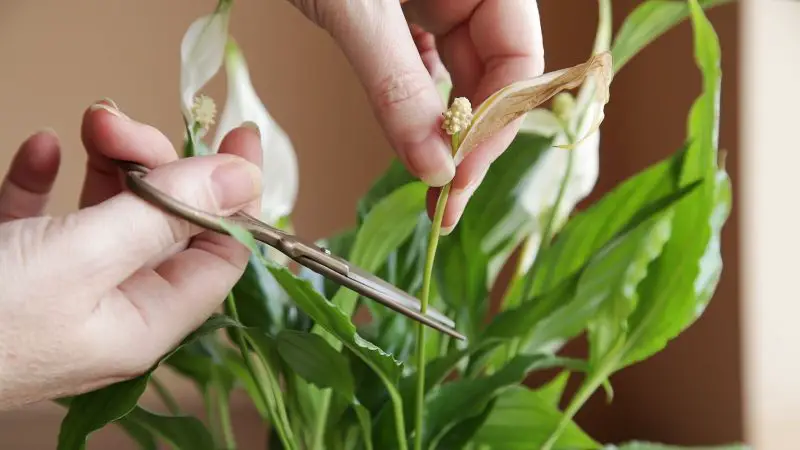Pruning a peace lily the right way helps the plant stay vibrant, balanced, and full of fresh growth throughout the year. Many growers admire peace lilies for their elegant white blooms, rich green leaves, and ability to thrive indoors with minimal effort. Yet few understand how proper pruning shapes the plant’s health and long-term beauty. Pruning is more than removing tired leaves. It directs energy toward new growth, prevents disease, and keeps the plant looking clean and structured. When done correctly, pruning encourages continuous renewal and helps the peace lily maintain its graceful form in any indoor space.
Understanding when and how to prune a peace lily makes the process simple and satisfying. The plant responds well to gentle trimming because its structure naturally produces fresh leaves from the center. Removing fading blooms, yellow leaves, or damaged stems allows new growth to emerge without strain. Pruning also improves airflow and light exposure, which strengthens the plant’s overall health. With the right timing, clean tools, and confident technique, you can guide your peace lily toward year-round beauty. This guide will help you master each step with clarity, ease, and consistent results.
Understanding Why Pruning Matters for Peace Lily Health

Pruning plays a vital role in keeping a peace lily healthy, structured, and full of energy. The plant grows from a central crown, which produces new leaves as older ones fade. When dead or damaged leaves remain attached, the plant wastes energy supporting tissue that no longer contributes to growth. Removing these leaves redirects nutrients toward new foliage and supports a cleaner appearance. This simple practice also reduces stress and keeps the plant focused on producing strong, vibrant growth. When pruning becomes part of regular care, the peace lily maintains a fresh and balanced shape.
Pruning also helps manage airflow around the foliage. Dense clusters trap moisture and create pockets where fungi can thrive. Removing crowded or aging leaves improves circulation and helps the plant dry evenly after watering. Better airflow reduces the risk of disease and prevents leaf edges from darkening. Clean space between leaves also allows more light to reach younger growth. Light plays a major role in the plant’s vigor. When lower leaves receive better exposure, they grow stronger and contribute to a fuller structure. Through pruning, the entire plant benefits from an improved environment.
Healthy pruning habits support long-term resilience. A peace lily occasionally faces moisture imbalance, temperature changes, or seasonal stress. When the plant carries unnecessary weight from dying leaves, it struggles more during these periods. Pruning removes sources of weakness and prepares the plant to handle minor fluctuations in care. It also strengthens the bond between grower and plant, as pruning encourages close observation. The more you understand leaf texture, color, and posture, the easier it becomes to decide when to prune. With proper timing and gentle technique, pruning ensures year-round beauty and steady indoor performance.
Identifying the Right Time to Prune Your Peace Lily
Knowing when to prune a peace lily helps you avoid stress and support consistent growth. The best time to prune is when leaves show clear signs of aging or damage. Yellow leaves, brown tips, and wilted stems indicate that the plant no longer benefits from those parts. Removing them early prevents energy loss and encourages new growth. Peace lilies naturally replace older leaves, so pruning helps speed this cycle. Understanding these signals makes pruning simple and smooth. The plant responds well when you follow its natural rhythm.
Seasonal changes also influence the ideal pruning moment. Peace lilies grow more actively in spring and summer when light increases and temperatures rise. During these seasons, pruning stimulates fresh leaves and improves airflow. In colder months, the plant grows slowly and prefers gentle care. Light pruning remains safe, but major trimming should wait for warmer conditions. Observing seasonal patterns helps you choose the best moment for healthier reactions. When pruning aligns with active growth, the plant recovers faster and strengthens more easily.
Blooming also affects pruning timing. Once the peace lily finishes blooming, the white spathes begin fading and turning brown. Removing spent blooms prevents the plant from wasting energy on aging flowers. This step encourages new blooms to develop and maintains a clean, elegant appearance. If blooms fade unevenly, prune individual ones as soon as they decline. Watching how the plant cycles through blooming and leaf growth helps you time your cuts with confidence. With proper observation, you can prune regularly without harming the plant. Pruning at the right time ensures long-lasting beauty and stable indoor health.
Preparing the Right Tools and Setup Before Pruning
Preparing the right tools ensures that your peace lily receives clean, precise cuts that support healthy regrowth. Using sharp scissors or pruning shears prevents crushing delicate leaf bases. Blunt tools tear tissue and slow healing, which increases the risk of infection. Before pruning, always disinfect your tools with alcohol to remove bacteria. This simple step protects the plant from unnecessary stress. Clean cuts heal faster and reduce the chance of rot entering the crown. When tools stay sharp and sanitary, pruning becomes safer and more effective.
Your pruning environment also affects the plant’s comfort and response. Choose a well-lit area where you can observe leaf texture and color clearly. Good lighting helps you identify which leaves truly need removal. Prune when the plant sits in stable temperatures, away from drafts or intense heat. Sudden environmental changes during pruning increase stress. Preparing a clean workspace prevents soil contamination and keeps debris from falling into the crown. A smooth environment encourages the plant to recover more quickly. Proper preparation ensures each cut supports healthier future growth.
Handling the plant gently makes pruning smoother and less disruptive. Lift leaves slowly to examine their bases and identify natural separation points. Avoid pulling or twisting leaves because this damages surrounding tissue. Supporting the plant with one hand while pruning with the other keeps movements controlled. After each cut, inspect the crown to ensure no torn fibers remain. Removing any loose tissue prevents moisture buildup and supports clean healing. Careful preparation allows you to prune with confidence and precision. When the setup feels organized and calm, your peace lily responds with stronger, more consistent growth.
How to Prune Dead Leaves, Spent Blooms, and Damaged Stems
Pruning dead leaves keeps your peace lily clean and prevents wasted energy. When a leaf turns yellow or brown, the plant no longer receives benefits from it. Leaving damaged leaves attached encourages moisture buildup and slows new growth. To prune correctly, follow the leaf stem down to its base and cut as close as possible without injuring the crown. This method removes the entire declining leaf and allows the plant to redirect energy toward fresh foliage. Consistent removal of aging leaves supports long-term health and improves the plant’s overall appearance.
Spent blooms also require careful pruning to maintain the plant’s elegant look. Peace lily blooms fade gradually, turning green, then brown, before collapsing. These older spathes drain energy that could support new flowers. Removing spent blooms encourages the plant to focus on developing fresh spikes. Follow the flower stalk to its base and trim it cleanly. Do not cut into the crown, as this damages developing tissues. Removing faded flowers promptly keeps the plant tidy and encourages more frequent blooming cycles. Each clean cut strengthens the plant’s natural ability to refresh itself.
Damaged stems appear when the plant experiences drought, physical impact, or fungal stress. These stems often fail to support healthy leaf growth and may spread weakness to nearby tissue. Inspect questionable stems carefully and remove them only when fully compromised. Cutting too early stresses the plant, while cutting too late risks spreading damage. Clean cuts help the plant heal faster and maintain structure. After pruning, observe how remaining leaves respond. Healthier leaves stand firmer and show improved color. Removing damaged tissue ensures the plant remains strong, balanced, and ready for continuous growth.
Shaping Your Peace Lily for a Fuller and More Balanced Look
Shaping a peace lily helps control its overall form and encourages fuller, more symmetrical growth. As the plant matures, new leaves emerge from the center while older leaves spread outward. Without shaping, the plant may lean, widen unevenly, or form gaps along the edges. Light pruning corrects these imbalances and helps the plant maintain a rounded, compact form. Removing older outer leaves gives younger inner leaves more space and brighter light. This simple technique encourages upward growth and strengthens the plant’s core structure. Over time, shaping creates a more refined appearance that enhances any indoor setting.
Shaping also depends on how the plant receives light. Peace lilies often lean toward the strongest light source, creating uneven leaf distribution. Pruning helps reset the plant’s structure, but rotation remains equally important. Combining gentle shaping with occasional rotation ensures even growth on all sides. Remove leaves that redirect the plant’s weight or shade developing shoots. When each section receives balanced light, new leaves grow straighter and fuller. This harmony transforms an uneven plant into a well-proportioned specimen. Shaping becomes easier once you understand how light and pruning work together.
Healthy shaping supports long-term density and prevents thinning. Over time, peace lilies may develop sparse inner growth if old leaves block airflow or shade young shoots. Removing heavy or downward-facing leaves allows light to reach deeper sections. This encourages new inner leaves to develop, creating a layered, lush appearance. With consistent shaping, the plant maintains vitality across every growth zone. These small adjustments create dramatic improvements in structure. A properly shaped peace lily appears fuller, brighter, and more visually balanced year-round, offering a calm and elegant presence in any room.
Managing Overgrown Peace Lilies With Selective and Rejuvenation Pruning
Overgrown peace lilies often develop thick clusters of leaves that block airflow and light. When the plant becomes dense, older leaves linger at the edges while new leaves struggle in the shadowed center. Selective pruning helps thin these crowded areas and restores balance. Remove the oldest, heaviest leaves first to create space for younger growth. This encourages the inner crown to breathe and strengthens early shoots. By restoring airflow and allowing more light to penetrate, the plant responds with cleaner structure and firmer leaves. Selective pruning prevents heaviness from pulling the plant downward and keeps its form upright.
Rejuvenation pruning becomes helpful when the plant shows patchy growth or multiple aging sections. This method involves removing several old leaves at once to redirect energy toward new foliage. Although this seems bold, peace lilies recover well when pruning aligns with warm seasons. Rejuvenation pruning encourages fresh development from the center, allowing the plant to rebuild density. Removing thick clusters around the crown prevents moisture from accumulating and reduces the risk of fungal issues. When done correctly, rejuvenation pruning transforms a tired plant into a lively and structured specimen.
Recovery after pruning requires careful observation and supportive conditions. Newly opened spaces allow more light to reach the core of the plant, which encourages faster growth. Consistent watering and steady humidity help the peace lily adapt without stress. Avoid direct sun because newly exposed leaves remain sensitive and require gentle light during recovery. Over time, the plant fills the gaps with vibrant, evenly spaced leaves. With selective and rejuvenation pruning, overgrown peace lilies regain their natural symmetry and develop year-round beauty. These techniques keep the plant strong, balanced, and visually refreshing.
Troubleshooting Common Pruning Problems and How to Fix Them
Yellowing or Drooping Leaves After Pruning
Yellowing leaves often appear when pruning cuts are placed too far from the leaf base. Small stubs trap moisture and develop soft tissue that spreads weakness to nearby leaves. This trapped moisture encourages decay and interferes with normal hydration. Many growers assume the yellowing means underwatering, but adding more water worsens the issue. The plant reacts to decay before it reacts to dryness. Understanding this subtle difference helps prevent unnecessary watering mistakes. Removing the leftover stub with a clean cut often solves the problem quickly.
Drooping leaves after pruning usually come from environmental stress rather than pruning damage. Peace lilies react strongly to sudden temperature changes or abrupt lighting shifts. Moving the plant right after trimming increases shock because exposed tissues remain sensitive. Keeping the plant in stable light and warm conditions prevents prolonged drooping. Check watering habits and allow the soil to stay lightly moist but never wet. As the environment stabilizes, leaves regain firmness. Understanding how the plant responds helps you correct the issue without overreacting.
Issues Caused by Improper Tools or Poor Sanitation
Improper pruning tools often create tearing instead of clean cuts. Torn stems heal slowly and increase the risk of infection. Dull blades crush tissue and create entry points for bacteria. Dirty tools introduce pathogens directly into the crown and leaf joints. These infections appear as dark, mushy spots near freshly trimmed areas. Infection spreads quickly because peace lily crowns hold moisture around new growth. Many growers mistake infection for overwatering, which delays proper treatment and increases stress.
To fix this problem, remove infected tissue using properly disinfected scissors. Clean tools with alcohol before every cut to prevent contamination. Allow the crown to dry slightly between waterings to reduce bacterial spread. Increase airflow around the plant and avoid misting until the tissue heals. Good sanitation creates a stronger recovery environment and prevents repeated infections. Once clean cuts replace damaged areas, the peace lily begins producing firm, healthy leaves. Proper tool care becomes essential for long-term pruning success.
Problems Caused by Light and Watering Mistakes After Pruning
Strong sunlight after pruning causes stress because newly exposed tissues remain sensitive. Direct sun burns soft leaf edges and slows the healing of trimmed stems. Even brief exposure can create pale patches or scorched marks. Many growers place the plant near bright windows without realizing how intense the light becomes. Peace lilies prefer soft, diffused light during the recovery period. Stable lighting allows the plant to adjust without losing moisture too quickly. Keeping the plant away from harsh rays ensures smoother healing.
Overwatering after pruning also complicates recovery. Moist soil slows healing around trimmed stems and increases the risk of crown rot. Freshly pruned plants should receive careful hydration rather than deep saturation. Soil that remains wet for too long traps moisture around the crown, especially when airflow is weak. Allowing the top layer to dry slightly between waterings encourages strong healing. Bright indirect light and balanced moisture help the plant recover faster. With gentle post-pruning care, your peace lily returns to firm posture and continues producing healthy new leaves.
Caring for Your Peace Lily After Pruning
Caring for your peace lily after pruning helps the plant recover smoothly and maintain strong growth. Fresh cuts need steady conditions to heal without stress. Keep the plant in warm indoor temperatures where drafts and sudden shifts are unlikely. Newly pruned plants lose moisture faster because exposed tissues adjust to environmental changes. Balanced humidity helps prevent dryness and supports early healing. Gentle airflow prevents moisture from settling around the crown. These stable conditions allow trimmed areas to close cleanly and encourage the plant to rebuild energy.
After pruning, watering must remain controlled and predictable. Peace lilies benefit from lightly moist soil, but excessive moisture slows healing around trimmed stems. Water when the top soil layer feels slightly dry. Deep watering is safe only when the plant has fully regained firmness. Freshly pruned plants often appear softer for a day or two, which is normal. Avoid fertilizing immediately because fresh cuts absorb nutrients poorly. Wait until new leaves form before resuming feeding. This patient approach protects the roots and encourages stronger foliage over time.
Light exposure also affects recovery after pruning. Bright indirect light supports gentle growth and prevents trimmed areas from drying too quickly. Direct sunlight stresses the plant and may damage newly exposed tissues. Keep the plant in a stable location to avoid unnecessary adaptation during recovery. As new leaves begin to appear, you may gradually adjust lighting if needed. Healthy recovery becomes clear when leaves stand firm and show deep green color. With attentive aftercare, your peace lily returns to its regular rhythm and prepares for fresh growth throughout the year.
Encouraging New Growth and Stronger Blooms After Pruning
Pruning creates an opportunity for your peace lily to direct fresh energy into new growth. Once old leaves and fading blooms are removed, the plant shifts resources toward producing stronger foliage. New leaves often emerge from the center, where growth remains most active. Keeping this area open allows better airflow and more balanced light exposure. These conditions help new shoots grow upright and firm. When the plant experiences stable moisture, warm temperatures, and gentle light, post-pruning growth becomes faster and more consistent. Over time, the peace lily forms lush layers of healthy leaves.
Blooming also improves when pruning supports the plant’s natural rhythm. Peace lilies produce flowers more reliably when old spathes are removed promptly. Old blooms drain energy that could strengthen new flower spikes. After pruning, consistent watering helps the roots remain active and absorb nutrients effectively. Bright indirect light fuels photosynthesis and gives the plant enough energy to develop new blooms. Avoid strong sun because it weakens emerging leaves and slows flower development. With balanced care, the peace lily begins forming flower stems that rise cleanly above the foliage. New blooms appear brighter and last longer.
Nutrition plays a major role in post-pruning recovery. Once the plant produces new leaves, introduce a diluted fertilizer to supply essential nutrients. Never feed immediately after pruning because fresh cuts absorb nutrients unevenly. Begin feeding only when new leaves reach stable size. A light fertilizer schedule during warm months supports bloom production and enhances leaf color. Avoid heavy feeding because peace lilies prefer gentle, steady nutrition. When the plant receives balanced care, it grows steadily and produces elegant blooms throughout the year. Proper encouragement after pruning ensures that your peace lily remains full, vibrant, and beautifully shaped.
Long-Term Pruning Strategy for Year-Round Peace Lily Beauty
A long-term pruning strategy helps your peace lily maintain an elegant shape and healthy growth throughout the year. Peace lilies grow steadily in indoor environments, so regular trimming keeps the plant clean, bright, and balanced. Light pruning every few weeks prevents old leaves from crowding younger shoots. This steady rhythm encourages the plant to renew itself without stress. Over time, small pruning habits create a fuller and more structured peace lily. Consistency ensures that the plant always has room to grow, breathe, and develop new layers of foliage.
Seasonal pruning also strengthens long-term beauty. During spring and summer, the plant grows more actively and responds well to moderate trimming. Removing older leaves during these warm months boosts airflow and allows new growth to develop faster. In autumn and winter, pruning should remain gentle because the plant slows its natural rhythm. Light removal of fading or yellowing leaves is enough to maintain structure. Seasonal awareness helps you avoid unnecessary stress and supports smooth growth cycles. When pruning matches the plant’s natural pattern, recovery becomes predictable and healthy.
Long-term success also depends on observation and careful adjustments. Monitoring leaf posture, root health, and hydration helps you decide when pruning becomes necessary. Proper lighting supports stronger post-pruning growth, while balanced moisture protects trimmed areas. Occasional rotation ensures even light on all sides and prevents leaning. These small actions protect your plant from uneven development. With a thoughtful pruning strategy, your peace lily remains full, symmetrical, and vibrant every month. The plant rewards consistent care with firm leaves, steady growth, and elegant blooms. Long-term pruning becomes an essential part of maintaining year-round beauty.
FAQs About Pruning Peace Lily
How often should I prune a peace lily?
Prune lightly every few weeks to remove fading leaves. This keeps the plant clean and encourages strong new growth. Major pruning works best in warm months. Small, regular trims prevent overcrowding and maintain balanced structure. Consistent pruning supports year-round beauty.
Why do trimmed leaves turn yellow after pruning?
Yellowing often happens when cuts leave small stubs that trap moisture. These stubs decay and weaken nearby tissue. Make clean cuts at the base to prevent issues. Keep moisture balanced and ensure good airflow. The plant recovers once damaged areas are removed.
Can pruning help my peace lily bloom more often?
Yes, pruning encourages more consistent blooming. Removing spent blooms redirects energy to new flower spikes. Clean foliage improves light absorption and strengthens growth. Balanced watering and bright indirect light support bloom development. With steady care, new flowers emerge more frequently.
Is it safe to prune a peace lily during winter?
Winter pruning should remain gentle because the plant grows slowly. Remove only yellow or damaged leaves. Avoid heavy shaping until warmer months. Keep conditions stable and avoid cold drafts. Light pruning maintains structure without stressing the plant.
Should I fertilize right after pruning?
Avoid fertilizing immediately after pruning because fresh cuts absorb nutrients poorly. Wait until new leaves appear. Start with diluted fertilizer during warm seasons. Balanced feeding supports healthy recovery and stronger growth. Gentle nutrition helps maintain long-term vigor.
Conclusion
Pruning a peace lily with care allows the plant to grow stronger, fuller, and more balanced throughout the year. Removing old leaves and faded blooms directs energy toward healthier growth. Clean tools, gentle handling, and steady conditions help each cut heal smoothly. Observing the plant after pruning ensures that light and moisture remain stable. With consistent attention, the peace lily rewards you with firmer leaves and brighter blooms. Over time, pruning becomes a simple habit that supports long-term vitality. A well-pruned peace lily brings calm beauty and natural elegance to any indoor space.






